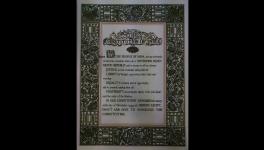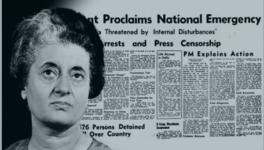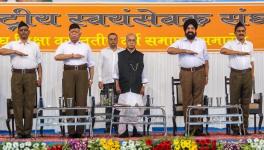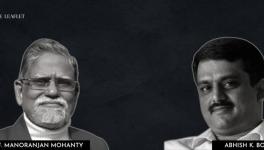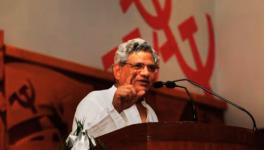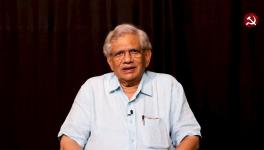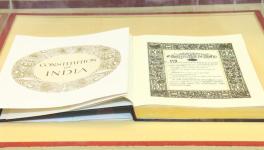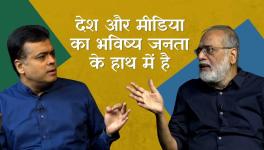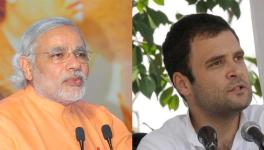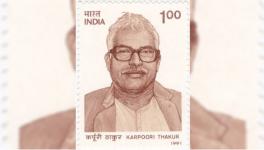Disruptive Arrival of The Emergency
As the world once again confronts an eruption of authoritarianism, Gyan Prakash's Emergency Chronicles: Indira Gandhi and Democracy's Turning Point offers a comprehensive historical account of Indira Gandhi's Emergency of 1975-77. By delving into the chronicles of the years preceding the Emergency, the book reveals how the fine balance between state power and civil rights was upset by the unfulfilled promise of democratic transformation.
Drawing on archival records, private papers and letters, published sources, film and literary materials, and interviews with victims and perpetrators, Prakash explains how the growing popular unrest disturbed Indira's regime, prompting her to take recourse to the law to suspend lawful rights, wounding the political system further and opening the door for caste politics and Hindu nationalism. The following is an excerpt from the book.
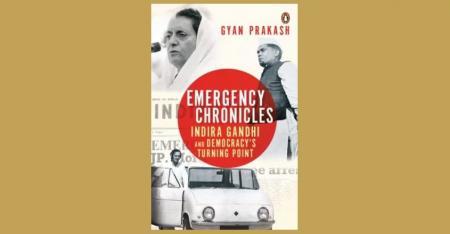
Prologue
On the recommendation of Prime Minister Indira Gandhi, the president of India declared a state of Emergency just before midnight on June 25, 1975, claiming the existence of a threat to the internal security of the nation. The declaration suspended the constitutional rights of free speech and assembly, imposed censorship on the press, limited the power of the judiciary to review the executive’s actions, and ordered the arrest of opposition leaders. Before dawn broke, the police swooped down on the government’s opponents. Among those arrested was seventy-two-year-old Gandhian socialist Jayaprakash Narayan. Popularly known as JP, Narayan was widely respected as a freedom fighter against British rule and had once been a close associate of Indira’s father, Jawaharlal Nehru. In 1973, JP had come out of political retirement to lead a student and youth upsurge against Indira’s rule. Although most opposition political parties supported and joined his effort to unseat Indira, JP denied that his goal was narrowly political. He claimed his fight was for a fundamental social and political transformation to extend democracy, for what he called Total Revolution…
Like many other regimes around the world during this time, Indira also faced the formidable challenge of a popular upsurge in the Jayaprakash Narayan–led movement. Though the opposition parties were entrenched in mobilizing protests, JP’s image as a veteran freedom fighter and a Gandhian uninterested in the loaves and fishes of office turned the confrontation into a contest over the very meaning of democracy. Indira responded with the emergency powers that the constitution provided. Over the twenty-one months that this authoritarian rule lasted, her government arrested over 110,000 opposition leaders and activists, including JP. It suppressed civil rights and left the victims with little recourse to courts, whose powers were severely curtailed. Armed with shadowy extraconstitutional powers, a coterie headed by her son Sanjay Gandhi ran amok; it punished and intimidated recalcitrant officials, ordered slum demolitions, and sent sterilization drives into high gear to control population growth. A gagged press ensured that the regime’s actions received only favorable coverage…
Undoubtedly, the role of Indira Gandhi looms large, for she cast a giant shadow on India’s postcolonial polity after the death of her father in 1964. She served uninterrupted as prime minister from 1966 to 1977 and once again from 1980 to 1984, winning massive victories in elections during most of her reign. Her instincts as a political tactician were impeccable as the opposition parties discovered much to their discomfiture. She was decisive in moments of crisis, acting on her own to take gambles in tackling challenges to her power. The Emergency was her handiwork. When the president issued a declaration under Article 352(1) of the Indian Constitution that “a grave emergency exists whereby the security of India is threatened by internal disturbances,” it was on her recommendation alone. He did not have the benefit of the advice of the Council of Ministers, which was kept in the dark until the next morning. The prime minister had claimed that the situation was so dire that it justified an exemption from the requirement that she seek the advice of her cabinet. Her judgment was enough. The slogan chanted by her henchmen, “India is Indira, and Indira is India,” spoke loudly about the power that stood behind the Emergency regime.
Carl Schmitt writes: “Sovereign is he who decides on the exception.” The sovereign decides what constitutes a situation of exception and what actions are needed to recover the normal juridico-political order from chaos. The state of exception discloses the true nature of sovereignty; the sovereign not only defines it but is also revealed in it. This applies to Indira, for she displayed her ruthless decisiveness in declaring and administering the Emergency. She not only defined what the normal rule was but also claimed a right to determine the exceptional circumstances that justified a break from it. When critics scorned her son Sanjay’s “extraconstitutional authority,” they challenged the legality of the Emergency and pointed to the underlying political will at work. The operation of political will, however, did not mean lawlessness because the constitution provided for the declaration of Emergency. The regime used a combination of existing laws on preventive detention, decrees, and constitutional amendments passed by the Parliament to dress its rule in a legal disguise. Such a regime was not purely juridical, for the deployment of extraordinary decrees and laws cannot be understood in strictly legal terms…
A Case of Mistaken Identity
When morning broke on September 25, 1975, Prabir Purkayastha had no idea that his life was about to change. The day began normally in his Ganga hostel dormitory in the New Campus of New Delhi’s Jawaharlal Nehru University (JNU). He got dressed and ate breakfast in the dining hall. Rather than wait for the shuttle bus, just after 9 a.m., he set off down the rocky shortcut that led from the ridge behind the dormitories to the Old Campus, which temporarily housed the university’s administration and classrooms. He strode past the craggy ridge of boulders and bushes that lined the uneven path and entered the campus through the back entrance. A few minutes later, Prabir was outside the School of Languages. Three students, all like him members of the Students’ Federation of India (SFI), were already gathered there. The SFI, affiliated with the Communist Party of India (Marxist), or CPI(M), was the dominant student organization on campus. One of its members, Devi Prasad Tripathi, was the president of the JNU students’ union.
On that morning, the campus was thick with tension. It was the second day of the three-day strike called by the SFI in response to the expulsion of Ashoka Lata Jain, an elected students’ union councillor, who also happened to be Prabir’s fiancée. Ashoka was no political firebrand, itching for a confrontation with the authorities. But she had crossed them by chairing a students’ union meeting and issuing a pamphlet, protesting the denial of admission to nineteen students on allegedly political grounds. One of them was Tripathi. Having completed his master’s at JNU, he had sought admission to the M. Phil. program in the Center for Political Studies. Denied admission, he was technically no longer a student and hence could not chair the students’ union meeting. That is why Ashoka had stepped in, provoking the authorities to expel her.
It was to carry out the SFI’s strike call to protest the university’s action that Prabir was at the School of Languages on the morning of September 25. The school was housed in a multi-story building constructed in the uninspiring public works style of generic modernism. An asphalt road, set between two arid lawns dotted with a few withered trees, branched south from the university’s main entry gate to the east. Prabir and his comrades stood on the road leading to the school entrance, approaching the few arriving students to persuade them to boycott classes. Devi Prasad Tripathi joined them briefly to discuss the day’s strike action before walking away to the library.
Around 10 a.m., a black car drove through the main gate, turned left, and continued toward the School of Languages. It was an Ambassador, one of the three automobile models manufactured in India and one invariably used by officialdom. At the wheel was a physically imposing Sikh, the DIG (deputy inspector general) of Delhi Police, P. S. Bhinder. With him were T. R. Anand, a DSP (deputy superintendent of police), and two constables, all in plainclothes.
The car stopped near the students. Bhinder got out, walked over to Prabir, and asked: “Are you Devi Prasad Tripathi?” Prabir replied that he was not. The next moment, he found himself being pushed toward the car. His friends rushed to save him from the plainclothesmen and momentarily succeeded in pulling him away from the car. Prabir also resisted, but the policemen beat back the students, lifted Prabir off his feet, and shoved him into the rear seat. Prabir’s friends screamed for help. One of them rushed to the driver’s side and tried to snatch the car keys from the ignition. But Bhinder came from behind, grabbed her hair, and hurled her to the ground. A flicker of hope rose momentarily in Prabir when he locked sights with a small group of students standing nearby, witnessing his ordeal. But it died as quickly as it had arisen when he saw them turn away with fear in their eyes. With the constables holding the slender, long frame of a struggling Prabir in the rear seat, his legs jutting out of the open door, the car reversed in high speed, turned in the direction of the entry gate, and raced out of the campus…
…But the immediate cause for Prabir’s kidnapping on September 25 was different. It began with an incident involving Maneka Gandhi, the nineteen-year-old wife of Sanjay. Growing up as Maneka Anand in a Sikh family, she had initially enrolled to study political science in 1973 at Delhi’s Lady Shri Ram College for Women, where she won a beauty contest. She began to work as a model, advertising bath towels on billboards and in magazines. However, this career ended abruptly when a chance encounter with Sanjay at a party in December 1973 quickly blossomed into a romantic relationship. On July 29, 1974, eighteen-year-old Maneka Anand was engaged to twenty-eight-year-old Sanjay Gandhi. Two months later, they weremarried in a quiet, private ceremony attended by close family members. By this time, Maneka was a student of German at JNU.
On the day Prabir was abducted, Maneka arrived on campus just before 9:00 a.m. for her class in the School of Languages. She got out of her black Ambassador and walked to the elevator to go up to her classroom. As she waited, Tripathi, accompanied by other students including Prabir, asked her to heed the strike call and boycott classes. “You are one of us, Mrs. Gandhi Junior!” Maneka exploded in anger. “Just you wait and see. Your heads will roll on the ground!” Then she stomped off. An hour later, another Ambassador entered JNU, and Prabir was whisked off.
As he waited at the R. K. Puram police station, Prabir continued protesting that he was not Devi Prasad Tripathi. His efforts were in vain. Meanwhile, ADM Ghosh (the area’s magistrate to whom Prabir and Ashoka had previously applied for recording their civil marriage) received a wireless message from the superintendent of police (SP) of South Delhi, Rajinder Mohan, summoning him to the Hauz Khas police station. Earlier that morning, Mohan had received a message from DSP Anand (the officer attacked by students after Prabir’s kidnapping) that some students had prevented Maneka from attending her class. Initially reported by the police officer accompanying her in the car to JNU, this information was quickly conveyed to Anand, who, in turn, promptly informed his superior, SP Mohan. Mohan then drove in his black Ambassador to JNU where Anand was waiting outside the gate. As they stood by the car, an agitated DIG Bhinder, the second highest-ranked Delhi police officer, showed up.
Less than an hour had passed since the incident involving Maneka, and three police officers were already assembled at the spot of reported trouble. Delhi Police is not famous for its speedy response to complaints by the citizenry. However, the complaining citizen in this case happened to be Sanjay Gandhi. And he voiced the grievance to no ordinary policeman but to the DIG of Delhi Police, Pritam Singh Bhinder. ..
On the morning of September 25, Bhinder had come to JNU directly from the prime minister’s house where Sanjay had grumbled that, according to Maneka, JNU was rife with antigovernment activities. Sanjay had asked him to take drastic action. Wasting no time, Bhinder jumped into his Ambassador and drove straight to JNU where the police officers Anand and Mohan were already gathered near the gate. Upon arriving, Bhinder asked them what information they had about Devi Prasad Tripathi. Although a warrant for arrest under MISA, the preventive detention law, for DPT awaited execution, the officers admitted that they did not know what he looked like, let alone his whereabouts. However, he had reportedly been seen recently in the School of Languages. This was enough for Bhinder. True to character, he announced he was going to make the arrest himself immediately. He left his own car with SP Mohan, got behind the wheel of the SP’s black Ambassador, and drove into the campus with DSP Anand and two constables.
ADM Ghosh knew none of this story when he entered the Hauz Khas police station. Officers at the station informed him that a student had been arrested in JNU, following a scuffle between the police and the students. As the story did not sit right with Ghosh, he summoned JNU officials to the police station. When the dean of students and the registrar arrived, they discovered from Ghosh that it was the police who had abducted Prabir. They protested the police’s unauthorized entry into the campus and demanded to know the reasons for his arrest. The magistrate then confronted SP Mohan with what he had learned from the university officials. The police officer then recounted a very different story from the one about a simple scuffle that ADM Ghosh had initially been told. No, there had been no arrest and no student scuffle with the police. In fact, Bhinder had driven into JNU and snatched a student named Devi Prasad Tripathi. But Ghosh knew from his talk with the JNU administrators that the student in custody was not Tripathi.
Ghosh was a young Indian Administrative Service (IAS) officer from the 1968 batch. Like Prabir, he was a Bengali and had grown up in a middle-class family. After completing his high school from Delhi Public School, he received a Science Talent Search Scholarship and entered the Indian Institute of Technology, Delhi, from which he earned a degree in chemical engineering. But while Prabir gravitated toward politics after his engineering education, Ghosh passed the civil service examination and was assigned to the IAS cadre that included the Union Territory of Delhi. It was in his capacity as ADM Delhi (South) that the engineer-turned-administrator had first en- countered the engineer-turned-political activist Prabir when he and Ashoka had applied for a marriage license. Encountering him now under very different circumstances, Ghosh set about piecing together the details he had gathered and noted the discrepancies in the police accounts. He concluded that Prabir’s arrest was a case of mistaken identity and declined to issue a warrant for his arrest. Placing the facts of the arrest before his superior, District Magistrate (DM) Sushil Kumar, Ghosh asked for guidance. Kumar informed him that since the issue involved the “PM’s house” (a euphemism for Sanjay Gandhi), he had to consult the Delhi lieutenant governor (LG) Krishan Chand. Meanwhile, Bhinder had already been in contact with the LG, boasting that he had found a “gold mine” of subversives in JNU. He flatly denied that it was a case of mistaken identity and claimed that, along with Tripathi, Prabir had been on his radar as one of the ringleaders. When SP Mohan informed him that Prabir’s name did not figure in the police list of student leaders targeted for arrest, Bhinder brushed him off. The decision was made, and he would be supplied with the necessary warrant. After consulting Bhinder, the LG instructed ADM Ghosh to issue a warrant since the information had come from above. ADM Ghosh, whom Prabir had approached to register his civil marriage to Ashoka, was now ordered to authorize his arrest. The issue of a MISA warrant required the police to submit justifying evidence to a magistrate. The police had not submitted any such evidence; it was supplied a few days later in an unsigned note. Yet Ghosh felt he had no option but to issue a warrant. Why? As he explained later, because the “practice was not to issue detention orders on the basis of subjective satisfaction of a Magistrate but to issue them on the directions of our official superiors.” Late that night, Prabir was transported from the police station to Tihar Central Jail in Delhi. He was later transferred to Agra, where he spent twenty-five days in solitary confinement.
The Emergency had produced a raging storm, and Prabir was one of its accidental victims. What created this maelstrom? And why did it rain down on the Nehruvian oasis of JNU? Founded to embody Nehru’s vision of a progressive, plural, and internationalist India, the university had witnessed no clashes over caste, religion, or region characteristic of national politics. The Emergency’s disruptive arrival on campus served notice that it would no longer be exempt from the convulsions of Indian politics. It suggests that understanding Prabir’s arrest requires us to place it not only in the glare of immediate events but also against the larger background of India’s experience with democracy, beginning with the constitution…
…Lawful Suspension of Law
…On February 29, 1976, the police arrested twenty-one-year-old Rajan along with another student from their dormitory at the Regional Engineering College in Calicut. Suspected of being Naxalite sympathizers, they were taken to a nearby police camp and tortured. Rajan’s father, a professor of Hindi, learned of his son’s arrest the following day and immediately went to the police camp. Although Varier was denied entry, the sentry at the gate confirmed that his son was being held inside. This camp was one of several torture chambers, called “workshops” in police parlance, in operation in the state. Among the torture methods they employed was one called the “ruler treatment,” or “rolling.” It involved placing the victim on his back on a bench with his head dangling off one end. The victim’s mouth would then be stuffed with his undergarments to muffle the sound of his cries of pain. A heavy wooden ruler would be placed on his legs and two policemen sitting on either end would roll it up the thighs of the victim. The pain would be excruciating, and the torture would tear the ligaments from the bone, which often cracked under pressure.
From the time he was turned away from the dreaded police camp, Professor Varier’s life, as he relates in his moving Memories of a Father, was consumed by the effort to find his missing son. He tried to move heaven and earth to get information, meeting the CPI leader and Kerala chief minister Achutha Menon and the home minister, petitioning Members of Parliament, and writing to newspapers. But no one was able or willing to provide any information on the whereabouts of his son. Acquaintances shunned him, afraid of associating with the father of a son accused of subversion. He suffered unspeakably, but the experience did not break him. The determined father pressed on, fortified by the memory of and love for his son. When the Emergency was lifted, he filed a habeas corpus petition before the Kerala High Court. The police denied that they had ever had Rajan in custody, but the evidence proved that they had arrested and taken him to the police camp, where he was tortured. The DIG (Crime Branch) was later convicted, but the conviction was overturned on appeal. Rajan’s body was never found. Apparently the police disposed of his body after torturing him. Professor Varier died in 2006, still grieving for the son whose body he never found:
My son is standing outside drenched in the rain. I still have no answer to the question whether or not I feel vengeance. But I leave one question to the world: why are you making my innocent child stand in the rain even after his death…
Get the latest reports & analysis with people's perspective on Protests, movements & deep analytical videos, discussions of the current affairs in your Telegram app. Subscribe to NewsClick's Telegram channel & get Real-Time updates on stories, as they get published on our website.









